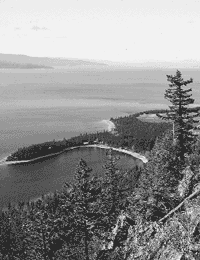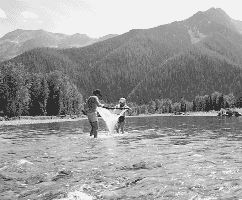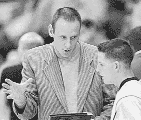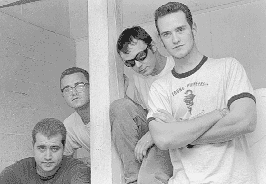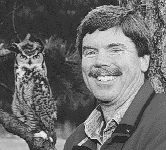Around the OvalArt on View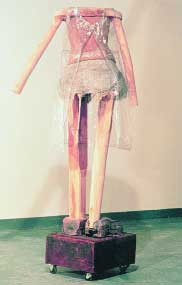 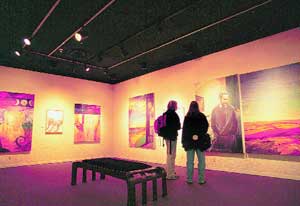 Galleries on campus bring a seasonal change of artistic works to the public's attention in a variety of settings. The Meloy Gallery in the Performing Arts and Radio/Television Center presented graduate thesis work last semester, including Kendra Bayer's mixed media "Seductress" (top left). In the University Center(top right), a once sober lounge for languishing and quiet study now features changing exhibitions of sculpture, painting and mixed media, including graduate student Anthony Lott's show "Dissociations: Spirit and Society" in February. The Gallery of Visual Arts in the Social Science Building displays works with an emphasis on canvas. The recent February show titled "Dreaming the West" featured such surrealist work as "Hinkley's Brain" by Jesse Valentine. Open to the public, all three galleries serve the University community as well as surrounding areas.
Galleries on campus bring a seasonal change of artistic works to the public's attention in a variety of settings. The Meloy Gallery in the Performing Arts and Radio/Television Center presented graduate thesis work last semester, including Kendra Bayer's mixed media "Seductress" (top left). In the University Center(top right), a once sober lounge for languishing and quiet study now features changing exhibitions of sculpture, painting and mixed media, including graduate student Anthony Lott's show "Dissociations: Spirit and Society" in February. The Gallery of Visual Arts in the Social Science Building displays works with an emphasis on canvas. The recent February show titled "Dreaming the West" featured such surrealist work as "Hinkley's Brain" by Jesse Valentine. Open to the public, all three galleries serve the University community as well as surrounding areas.
Greetings from the President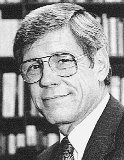 I extend to you our collective best wishes for a wonderful and productive 1999. It seems incredible that the new millennium will dawn within a few months. Having lived in the century that truly tried human ingenuity and resourcefulness, I eagerly await the new one.
I extend to you our collective best wishes for a wonderful and productive 1999. It seems incredible that the new millennium will dawn within a few months. Having lived in the century that truly tried human ingenuity and resourcefulness, I eagerly await the new one.
As I considered an appropriate message for this issue of the Montanan, I came to a deeper appreciation of the University's leadership in the arts throughout Montana and the region. In the new century, colleges and universities must reassert their traditional missions to ensure the continuation of our common culture. I make this statement with the clear intention of maintaining the culture's eclectic nature, borrowing as it has from the aboriginal population and the successive waves of immigrants. Robert Bellah informed us some years ago that we best define a culture as a continuing dialogue about things that matter among people who care. We do have much in common, even as we celebrate our diversity. Through numerous initiatives, The University of Montana strives to fulfill its unique mission in the arts. This issue of the magazine will introduce some faculty members and students who have, through their commitments and accomplishments, moved us in the appropriate directions. The richness of the campus resources and the creativity of the people who constitute the University offer proud testament to our continuing commitment. I remain optimistic about the future of the University and our society despite the problems we face. Henry Adams, one of America's great intellects, contemplated the opening of a new century one hundred years ago. He discounted the warnings of the skeptics who argued that the human mind lacked the scope and power to resolve or even to comprehend the new challenges. He believed humanity up to the task, although he concluded that the human mind would "have to leap." It did, and so it will in the new century if we but prepare young people properly.
UM Biological Station: A Century of Ecology Research
Montana's Flathead Lake, one of the world's three hundred largest lakes, has maintained a clean reputation in times when much of the world's waters have been polluted to irreversible levels. Yet reputation alone could not protect the largest freshwater lake west of the Mississippi River from water-quality decline forever. The University's Flathead Lake Biological Station at Yellow Bay is a watchful guardian of the lake. Since 1977, under the direction of Jack Stanford, station scientists have studied trends in the lake's water quality, keeping lake managers informed. The station, which has no managerial authority, provides scientific information for the protection of Flathead Lake and its surrounding ecosystem. The station has been concerned with the Flathead ecosystem for much longer than twenty-two years. Morton J. Elrod, the first director, established the biological station in 1899 at the mouth of the Swan River. That site north of Yellow Bay was a place for scientific study and teaching until 1912, when the station moved to its present location. Since its beginning, the biological station has been dedicated to teaching scientific field courses. As years passed, ecological research also became a significant priority. Today the biological station staff works year-round toward four goals: to conduct and publish basic research in ecology, with an emphasis on the Flathead River/Lake ecosystem; to offer quality college courses in field-oriented ecological disciplines; to train graduate students in ecology; and to provide information to the public on ecological issues. To mark its centennial, biological station faculty and staff will celebrate this summer with a series of public events, including guided hikes, a fishing derby and seminars. A $10 million Capital Campaign will finance buildings, professorships and equipment purchases to take the station into the next millennium. Swish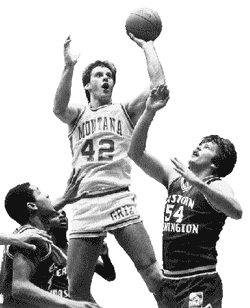 Larry Krystkowiak's celebrated number 42 was retired in 1989, honoring his four great years playing power forward for the Griz before being drafted in 1986 by the NBA. He went on to play with the San Antonio Spurs, the Milwaukee Bucks and the Utah Jazz.
Larry Krystkowiak's celebrated number 42 was retired in 1989, honoring his four great years playing power forward for the Griz before being drafted in 1986 by the NBA. He went on to play with the San Antonio Spurs, the Milwaukee Bucks and the Utah Jazz.
The number may be hanging up, but Krsytkowiak himself shows no sign of slowing down. Returning to his alma mater in fall 1998, the amiable athlete now has an office and official duties on campus, assisting head coach Don Holst with this year's Griz team. "I've always been a Grizzly," Krystkowiak says proudly. Ever since his playing days ended, he had been interested in coaching, and when the opportunity to coach at UM presented itself, Krystkowiak, well, jumped. Now as assistant coach he spends a lot of time behind the scenes, dealing with everything from players' academic performances to fan attendance. This season poses a special challenge for Krystkowiak, as well as players and fans--the use of Sentinel High School's gym while UM's nine-thousand-seat events center is renovated. "If we can weather this, well, it'll never be more difficult than this," he says. Sounding every inch a coach, he adds, "When I was rehabbing my knee, the doctor used to say to me, 'If it doesn't kill you, it'll make you stronger.'" Paddle on, DudeThe University isn't all study and research. In fact, UM was named one of the top ten universities in the nation for canoeing, kayaking and rafting in the September/October 1998 issue of Paddler magazine.In a section titled "The Nation's Best Paddling Colleges" an article, accompanied by a photo of a kayaker flying off Kootenai Falls, described the University, UM's Campus Recreation Outdoor Program and some Missoula watering holes and restaurants. "They looked at where the University was located when making their selections," Outdoor Program manager Dudley Improta says. "We have a lot of good runs close to campus on the Blackfoot River and the Alberton Gorge on the Clark Fork. We also are close to Idaho rivers like the Lochsa and the Salmon." Improta and his staff maintain a fleet of canoes, rafts and various inflatables. Campus Recreation offers paddling classes, trips and rentals to the campus community and members of the Alumni Association, and Improta says the program stays busy with river trips from mid-April to mid-September. Paddler is a national canoeing, kayaking and rafting magazine based in Steamboat Springs, Colorado. Best BuyFor the second year, UM was singled out as an American university that gives students and parents the best value for their education dollar. America's 100 Best College Buys highlights colleges and universities that are rated highest academically but have costs below the national average. The institutions listed also have incoming freshman classes with grade-point averages above the national average. "These are all 'value-added' colleges, where a top-notch college education is available for a reasonable cost," says John Culler, the book's publisher. "This ranking provides solid evidence of our continued effort to make sure we protect the relationship between price and quality," says UM President George Dennison. "We have kept prices down and quality high, and that has earned recognition. We intend to make even greater efforts in the future." UM also was featured in Barron's Best Buys in College Education, 5th Edition, which lists the top three hundred American four-year colleges and universities that give the best value for the education dollar. Science Breaks a UM BreakthroughIn an imaginative leap propelled equally by scientific theory, intuition and luck, UM virologist Jack H. Nunberg and research associates have succeeded in creating the first prototype vaccine that can induce antibodies--in mice--capable of neutralizing genetically diverse strains of HIV grown from the blood of infected individuals from around the world. "We believe we have opened a door onto a new avenue of HIV research that may one day lead to development of an effective HIV vaccine," says Nunberg, head of the Montana Biotechnology Center at UM and a professor of biological sciences. Nunberg, former doctoral student Rachel LaCasse, postdoctoral fellow Meg Trahey, senior research associate Kathy Follis and Dan R. Littman of the New York University School of Medicine, reported their findings in December's issue of the journal Science. The success of Nunberg's vaccine approach hinges on capturing HIV in the midst of its intricate dance of binding and fusion with T lymphocytes, the immune system's primary target of HIV attack. The vaccine is made of proteins from the virus' outer envelope in active combination with certain receptor molecules on the surfaces of T cells. Such "fusion-competent" immunogens apparently more closely mimic the conditions of active infection by twenty-three of twenty-four genetically diverse HIV types found in the United States, Europe, Africa, India and Thailand. Professor of the YearAnnie Sondag, UM professor of health and human performance, won the 1998 Montana Professor of the Year Award from the Council for Advancement and Support of Education and the Carnegie Foundation. Her win brings the coveted CASE award back to UM for the first time since Regents Professor Paul Lauren won it in 1991. The award recognizes Sondag for her exceptional service to her profession as a health educator, researcher and participant on a range of curricular and policy-making committees in the state and region. "Annie Sondag is an individual of uncommon commitment and talent," says Sharon Dinkel Uhlig, associate dean of the School of Education. Uhlig says Sondag is an accomplished scholar and devoted public servant with enviable teaching abilities. At state and regional levels, Sondag is considered one of the elite health educators in Montana. She represented health education at the Health Enhancement Summit Conference in 1996, a conference that occurs every five years and sets standards for state agencies and organizations concerning the health needs of young children and adolescents. She was one of four authors of Health Enhancement: Montana and National Standards, which now serves as the guiding document for all Montana K-12 school curriculum development. CASE is an international association of colleges, universities and independent elementary and secondary schools that focuses on alumni relations, communications and fund-raising. CASE established the Professors of the Year program in 1981 and administers it with the Carnegie Foundation for the Advancement of Teaching and various higher education associations.
Moving OnSheila Stearns, chancellor of Western Montana College in Dillon and former vice president for UM relations, has accepted the presidency of Wayne State College in Wayne, Nebraska. She assumes her new role July 1. Currently, Stearns and her husband, Hal, are serving as UM's part-time legislative liaisons during the 1999 session. Stearns has been chancellor at WMC since 1993. She earned bachelor's, master's and doctoral degrees at UM.Click HereUM's Web site offers a great way to keep up with campus activities, stay in touch with fellow alums and find out the very latest in UM news. With a changing snapshot of campus and daily feature articles about University people and events, the site offers access to the Mansfield Library card catalogs, the alumni home page, Grizzly Athletics, the Kaimin, Cut Bank--UM's literary magazine--and more. Subscribe to the campus Internet newsletter or find out about recent faculty publications. The site, which offers links to many Missoula sites, is a great way for parents to learn more about campus. Make UM your home page as well as your home team. Visit us at www.umt.edu. New Yorker Punks Out
The magazine portrayed the band as an emblem of today's youth culture, complete with apathy and mustard sandwiches. The journalist traveled with the band members for a few weeks last summer as the Sputniks finessed a do-it-yourself tour and camped out in vans and closets. The band members, who come from a long line of UM graduates, didn't mind taking some time off from their studies or their own work in journalism (Chad presently writes for the Kaimin; Zach works at the Missoula Independent) to pursue their head-banging passions and pose a bit for the magazine's photographer. Has the New Yorker exposure affected the fate of the Sputniks any? Zach Dundas remarks, "Our fan base among middle-aged English professors is way up." Watching HuttoHutto is the new host of "BirdWatch," a national public television series dedicated to all aspects of birds and bird-watching. The ten-part, magazine-style series showcases birds in wildernesses and backyards throughout the United States. "BirdWatch" caters to the eighty million Americans who make bird-watching one of the nation's most popular outdoor hobbies. Hutto has filmed segments of "BirdWatch" in places as far flung as the Patagonia-Sonoita Creek Preserve in Arizona, one of the country's premier birding hot spots, and New York City's Central Park, where red-tail hawks nest over Fifth Avenue. Other episodes have been taped closer to home. Hutto featured short-eared owls in the Mission Valley twilight, Pattee Canyon goshawks above Missoula and a variety of birds along the Bitterroot River. Hutto isn't the only UM professor with a national bird-watching show. His colleague, Professor Ken Dial, hosts a program titled "All Bird TV" on the Animal Planet channel. For more information visit the program's Web site at www.wbu.com/birdwatch. Proven LeaderPresident George Dennison's leadership and vision at UM have captured the attention of peer institutions across the Northwest. Dennison received the prestigious 1999 Council for Advancement and Support of Education District VIII Leadership Award during the organization's annual conference in Portland, Oregon, in February. The award recognizes Dennison's role as a leader, supporter and participant in institutional advancement, says Cassie S. McVeety, chair of the CASE District VIII board of directors. It also demonstrates he is recognized and respected by his peers, she adds.Under Dennison's leadership, funded research at UM has increased each year-- from $7 million when he arrived in 1990 to more than $26 million in 1997-98. He also led the most successful Capital Campaign in Montana's higher education history, raising more than $71 million for UM. CASE District VIII comprises professionals in advancement positions at educational institutions in Montana, Idaho, Washington, Oregon, Alaska and four Canadian provinces.
In Memoriam Professors Emeriti Rueben Diettert and Thomas Payne will long be remembered by UM as inspirational teachers of botany and political science, respectively. But the two, who died a day apart in November, also left their marks on local and state communities.
Professors Emeriti Rueben Diettert and Thomas Payne will long be remembered by UM as inspirational teachers of botany and political science, respectively. But the two, who died a day apart in November, also left their marks on local and state communities.
Diettert, a thirty-seven-year veteran of UM's botany department and the founder of the Montana State Science Fair, died of natural causes November 22 in Missoula. He was ninety-seven years old. Payne died at age seventy-eight November 23, after a long battle with Parkinson's disease. Famed for his green thumb, Diettert chaired the botany department during 1956-66. On the side, he started the University's bowling league, designed Missoula's Memorial Rose Garden and served nine years on the local high school board. He was honored in 1997 for attending every Grizzly home basketball game for sixty years. Payne taught at UM during 1951-87, specializing in American political behavior and topics such as political parties, interest groups, elections and campaigns. He also participated in the political process, twice running unsuccessfully for the state Legislature and serving three years on the Montana State Commission for Local Government. In 1984 he received UM's first Distinguished Service Award. He received the Robert T. Pantzer Award in 1986 for helping make UM a more open and humane learning environment.
Running in Space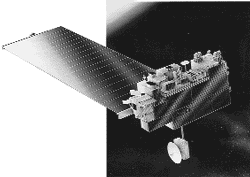
If all goes according to plan, software designed by UM forestry Professor Steve Running will be launched into orbit July 15. Since 1992 Running has used a $7.9 million NASA grant to create software for the Earth Observing Satellite, a $7 billion machine that will monitor forest ecosystems from space. Running's program, which will measure vegetation cover across the globe, can be used to predict the likelihood of forest fires, study drought conditions and chronicle other global changes. The satellite will be a premier instrument for measuring global warming. Running wrote the software with a team of about a dozen UM faculty and graduate students. He says the satellite will bring major attention to UM after the July launch, since he and his staff will train experts to interpret the data the satellite gathers. Running has worked with NASA since 1981, when the space agency decided to expand its scientific research team to include a variety of scientists such as ecologists. Masters of the Media Arts
"The only people who advance in television, for example," Murphy says, "are the writers--the people who understand the guts of what story is." Story is so important in media arts that faculty members start out with the basics, "the beginning, the middle and the end," before working their way up to interactive technologies such as CD-ROM. Developed by Murphy and drama Professor James Kriley, the three-year program hopes to give students a sense of today's "multilinear" narrative. And this, Murphy thinks, will keep UM at the cultural frontier.
"Students aren't aware of the stories they're being fed all the time," he says. "This teaches them to interact with story in a meaningful way."
|
